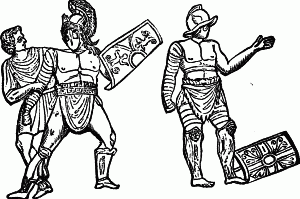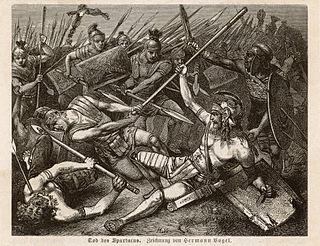
A gladiator was an armed combatant who entertained audiences in the Roman Republic and Roman Empire in violent confrontations with other gladiators, wild animals, and condemned criminals. Some gladiators were volunteers who risked their lives and their legal and social standing by appearing in the arena. Most were despised as slaves, schooled under harsh conditions, socially marginalized, and segregated even in death.

Commodus was a Roman emperor who ruled from 177 until his assassination in 192. For the first three years of his reign he was co-emperor with his father Marcus Aurelius. Commodus' sole rule, starting with the death of Aurelius in 180, is commonly thought to mark the end of a golden age of peace and prosperity in the history of the Roman Empire.

The Colosseum is an elliptical amphitheatre in the centre of the city of Rome, Italy, just east of the Roman Forum. It is the largest ancient amphitheatre ever built, and is still the largest standing amphitheatre in the world, despite its age. Construction began under the Emperor Vespasian in 72 and was completed in AD 80 under his successor and heir, Titus. Further modifications were made during the reign of Domitian. The three emperors who were patrons of the work are known as the Flavian dynasty, and the amphitheatre was named the Flavian Amphitheatre by later classicists and archaeologists for its association with their family name (Flavius).

The Gloster Gladiator is a British biplane fighter. It was used by the Royal Air Force (RAF) and the Fleet Air Arm (FAA) and was exported to a number of other air forces during the late 1930s.

Sword-and-sandal, also known as peplum, is a subgenre of largely Italian-made historical, mythological, or biblical epics mostly set in the Greco-Roman antiquity or the Middle Ages. These films attempted to emulate the big-budget Hollywood historical epics of the time, such as Samson and Delilah (1949), Quo Vadis (1951), The Robe (1953), The Ten Commandments (1956), Ben-Hur (1959), Spartacus (1960), and Cleopatra (1963). These films dominated the Italian film industry from 1958 to 1965, eventually being replaced in 1965 by spaghetti Western and Eurospy films.

The Third Servile War, also called the Gladiator War and the War of Spartacus by Plutarch, was the last in a series of slave rebellions against the Roman Republic known as the Servile Wars. This third rebellion was the only one that directly threatened the Roman heartland of Italy. It was particularly alarming to Rome because its military seemed powerless to suppress it.

Asterix the Gladiator is the fourth volume of the Asterix comic book series, by René Goscinny (stories) and Albert Uderzo (illustrations). It was first serialized in the magazine Pilote, issues 126–168, in 1962.

Simon Scarrow is a British writer. Scarrow completed a master's degree at the University of East Anglia after working at the Inland Revenue, and then went into teaching as a lecturer, firstly at East Norfolk Sixth Form College, then at City College Norwich. Simon is a patron of the Bansang Hospital Appeal which supports an outstandingly innovative hospital in The Gambia.

Gladiator is a 2000 epic historical drama film directed by Ridley Scott and written by David Franzoni, John Logan, and William Nicholson. It stars Russell Crowe, Joaquin Phoenix, Connie Nielsen, Tomas Arana, Ralf Möller, Oliver Reed, Djimon Hounsou, Derek Jacobi, John Shrapnel, Richard Harris, and Tommy Flanagan.

The Ludus Magnus, also known as the Great Gladiatorial Training School, was the largest of the gladiatorial schools in Rome. It was built by the emperor Domitian in the late first century C.E., alongside other building projects undertaken by him such as three other gladiatorial schools across the Roman Empire.

Gladiator: Sword of Vengeance is a hack and slash video game developed by Acclaim Studios Manchester and published by Acclaim Entertainment for PlayStation 2, Xbox and Microsoft Windows. A GameCube version was cancelled. During development, the game was titled I Gladiator. Throwback Entertainment acquired the rights to several of Acclaim's properties in 2006, including Gladiator: Sword of Vengeance.

The Borghese Gladiator is a Hellenistic life-size marble sculpture portraying a swordsman, created at Ephesus about 100 BC, now on display at the Louvre.

The inaugural games were held, on the orders of the Roman Emperor Titus, to celebrate the completion in AD 80 of the Colosseum, then known as the Flavian Amphitheatre.

The Gladiator Mosaic is a famous set of 5 large mosaics of gladiators and venators and two smaller ones. The mosaics are dated to the first half of the 4th century and are now installed in the Salone of the Galleria Borghese in Rome. They were discovered in 1834 on the Borghese estate at Torrenova, on the Via Casilina outside Rome. Prince Francesco Borghese Aldobrandini requested the excavations be completed. It is believed to have decorated a cryptoporticus of an inner peristylum for a large domus. The mosaics were removed from excavations and restored by Gaetano Ruspi and Filippo Scaccia in 1839. These panels reinvigorated the Borghese Collection after it had shrunk following the sale of much of the collection to Napoleon I.

A Samnite was a Roman gladiator who fought with equipment styled on that of a warrior from Samnium: a short sword (gladius), a rectangular shield (scutum), a greave (ocrea), and a helmet. Warriors armed in such a way were the earliest gladiators in the Roman games. They appeared in Rome shortly after the defeat of Samnium in the 4th century BC, apparently adopted from the victory celebrations of Rome's allies in Campania. By arming low-status gladiators in the manner of a defeated foe, Romans mocked the Samnites and appropriated martial elements of their culture.

Spartacus was a Thracian gladiator (Thraex) who was one of the escaped slave leaders in the Third Servile War, a major slave uprising against the Roman Republic.
Nitish Roy is an Indian film art director, production designer, and costume designer in Hindi cinema and a Bengali Film Director, who is also known for his work with art cinema directors, Shyam Benegal, Mrinal Sen and Govind Nihlani, Hindi mainstream cinema, directors like Rajkumar Santoshi, as well as international directors like Mira Nair and Gurinder Chadha. His work for Oscar winning Hollywood blockbuster Gladiator fetched international fame for him. Beside art direction, production design and film direction he is an internationally acclaimed architect who has created several film cities such has Ramoji Film City (Hyderabad) Innovative Film city (Bengaluru),Prayag Film City (Kolkata) and several theme parks, amusement parks, museum not only in India but also in countries like Singapore etc.

Gladiators of Rome is a 2012 Italian computer-animated comedy film produced by Rainbow, a studio co-owned by Iginio Straffi and Viacom at the time. Viacom's Paramount Pictures released the film in North America while Medusa Film handled distribution in Italy. The film was directed by Straffi, who also co-wrote the screenplay with Michael J. Wilson. Gladiators of Rome had its world premiere in Italy on 18 October 2012.

Gladiator Academy is a children's animated television series created by Claudio Biern Boyd, who also created The World of David the Gnome. The series was targeted to children aged 6 to 10 and premiered on Telecinco in 2002. It was a co-production between Telecinco and Boyd's company BRB Internacional.


















